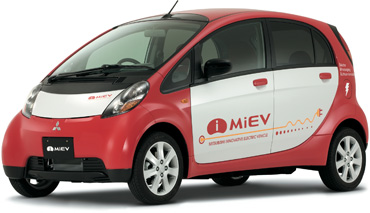
LOS ANGELES – Having launched the i-MiEV electric vehicle in utility fleets in the U.S. late last month, a Mitsubishi Motors North America official hopes similar efforts by other auto makers pay off, as well.
“Right now, anything in electric drive I hope is a success, because if (the technology is) not successful, it’s going to poison the waters (for everyone),” Dave Patterson, senior manager-regulatory and certification-global emissions for MMNA, tells Ward’s.
Patterson makes his remarks during an interview when asked his opinion of General Motors Corp.’s upcoming Chevy Volt and BMW AG’s Mini-E concept shown at the recent Los Angeles auto show.
Reiterating parent Mitsubishi Motor Corp.’s stance to explore plug-in hybrid-electric vehicle technology for larger models, such as SUVs, Patterson nevertheless is concerned about the added cost and complexity of combining a long-range electric battery and gasoline engine to power a vehicle.
“As an engineer, I look at the (Volt) and go, ‘Wow, I’ve got two propulsion systems; I’ve got two energy systems. All this adds weight, costs, complexity. Who is going to service this thing?’” he says.
Mitsubishi developed a vehicle similar to the Volt in 1995, he says, with a 40-mile (64-km) range on a single charge but with an engine powered by compressed natural gas.

“The first time around, (auto makers with EVs) did the worst (public relations) work for our industry,” Patterson says of early efforts at adoption in the U.S., including GM’s now infamous EV1.
Concern about servicing EVs is one reason Mitsubishi will emphasize fleet sales next year, when it begins retailing the i-MiEV in Japan. The car can travel 75 miles (121 km) on a single charge.
“If we have 20 fleets of 100 vehicles, it’s going to be a lot easier for us to learn how to service them,” Patterson says of the plan to sell 2,000 i-MiEVs in Japan.
However, private buyers will be able to go to any Mitsubishi showroom in Japan next summer and order an i-MiEV, he says, noting the auto maker hopes to “multiply by a factor of two” i-MiEV sales there in each successive year.
In the U.S., MMNA is placing i-MiEV prototypes into electric-utility company fleets in Southern California. The auto maker has delivered vehicles to Southern California Edison and Pacific Gas and Electric within the last several weeks.
Meanwhile, Patterson is traveling throughout North America meeting with government officials to learn how to expand EV acceptance, while also promoting the idea of tax incentives and infrastructure improvements.
Trips to Canada have been frequent, he says, as the government is in the process of establishing a “technology roadmap for the next 10 years.”
Patterson says he would like to see the U.S. government offer incentives of at least $10,000 per EV to encourage consumer acceptance of such vehicles.
The Japanese government gave Mitsubishi close to $16,000 in incentives for retail, he says, adding the government also is offering “huge breaks” on annual road taxes and registration fees for consumers who purchase an i-MiEV.
Mitsubishi is not giving an on-sale date for launch of a production i-MiEV in the U.S., preferring to take its time and learn lessons from the fleet experience in California.
In Japan, Mitsubishi learned lack of ride quality was a common concern.
“That’s one of the things that continually comes up,” says Patterson. “It’s one of the things we’re still working on. (The i-MiEV) is production intent. (Mitsubishi) wants to have this vehicle be transparent to non-EV enthusiasts.”
Another focus is tamping down kickback from the regenerative braking system. “Will a standard customer like (kickback)? We’re not sure,” Patterson says.
Mitsubishi claims it will be the first auto maker to begin building automotive-scale lithium-ion battery packs when it launches production next year through a partnership with investment-firm Mitsubishi Corp. and GS Yuasa Corp. called Lithium Energy Japan.
Despite recent proclamations by rival Nissan Motor Co. Ltd. that its Li-ion joint venture will be first to launch production, Patterson says his battery experts in Japan cast doubt on that claim.
For now, Mitsubishi is focused on launching the small i-MiEV, based on its gas-powered A-segment ‘i’ car sold in Japan.
Given its experience in working on the Smart Forfour with former partner DaimlerChrysler AG, Patterson is confident Mitsubishi can make the production i-MiEV meet U.S. safety standards.
“We had quite a bit of input into the Smart car,” he says. “We know how to make a vehicle like this comply with safety standards (here) by retrofitting it.”
For example, Mitsubishi is considering widening the i-MiEV’s track by 3-4 ins. (7.6-10.2 cm) to make it suitable for sale in the U.S. market.


